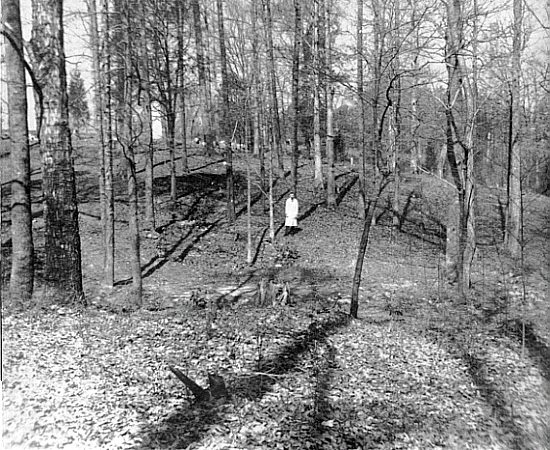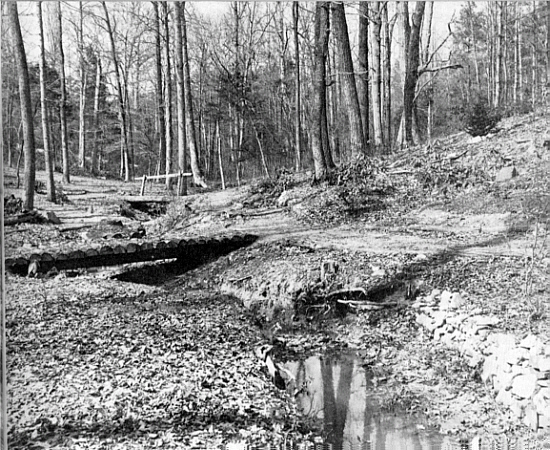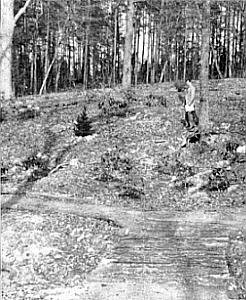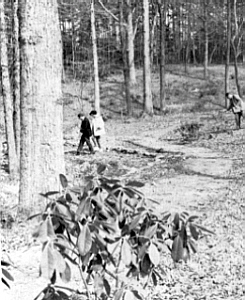QBARS - v23n4 The Van Landingham Glen
The Van Landingham Glen
at the University of North Carolina at Charlotte
Dr. Herbert Hechenbleikner, Charlotte, N.C.

|
||||
|
Fig. 68. Van Landingham Garden. Photo made in March 1966 after basic
thinning and clearing was completed. Photo by Dr. Hechenbleikner |
||||

|
||||
|
Fig. 70. Van Landingham Garden. April 1969 showing the same area as Fig. 68
but from a different angle. The bridge and path edgings are of black locust. ( Robnia pseudo-acacia ) from western North Carolina which is very durable against decay. Dr. Hechenbleikner photo |
||||
|
In 1960, Ralph Van Landingham decided to convert an old fashioned, largely overgrown five acre yard into a rhododendron garden. With the help of Charles Dewey and others, but mainly the former, he began planting rhododendrons. In 1966, after having had success with these plantings, he became interested, with the author, in a rhododendron garden at the University of North Carolina at Charlotte.
The site chosen was almost ideal. Tall trees-many had to be cut in the initial thinning operation-furnish high shade. In the center of the wooded, rather rocky slopes two small streams converse. The soil is a sandy loam with considerable humus content, and good drainage. An indigenous plant also indicated this as a good site, for along one branch were several native Azalea nudiflorum , some as much as seven feet tall. The ground, in places, is literally carpeted with wild ginger ( Hexastylis arifolia ) and hepatica ( Hepatica americana .) There are presently about 250 hybrid rhododendrons of blooming age together with 700 small plants which should begin blooming during the next two to five years. In addition, there are several dozen specimens of native azaleas, rhododendrons, and various woody and herbaceous plants native to the western North Carolina mountains.
The pH of the soil varies from 5.5 to 6.5, being lower or more acid in the center section of the site where the soil is mostly clay rather than a sandy loam. Two of the native rhododendrons and several of the native azaleas as well as Kalmia will grow without difficulty in this soil so they will be planted in this area.
In a sunny more open area on one slope are beds reserved for R. minus and R. carolinianum which have been collected from sites scattered over the Piedmont and in the edge of the Coastal Plain of North and South Carolina. One of these localities is only a few miles from Columbia, S.C. on a clay hill situated amidst coastal plain sands where the summer temperatures are sometimes over 100 and September and October are typically very dry months with high temperatures.
Some of the hybrid rhododendrons, of blooming size, planted in February 1966 are: 'A. Bedford', 'Cynthia', 'Pink Pearl', 'Vulcan', 'Gomer Waterer', 'Mrs. Betty Robertson', 'Mrs. Furnival', catawbiense album , 'Autumn Gold', 'Mrs. Chas. Pearson', etc. Only the last named has suffered marginal leaf damage from winter winds. A white pine ( Pinus strobus ) hedge has been started as a wind break.
During recent months several small specimens of the large leaved falconeri and grande series have been planted. It is still too early to evaluate their hardiness and growing potential here in the Piedmont.
A primary concept of this garden is to keep it as natural as possible in appearance with no exotic plants, whatsoever, except the hybrid rhododendrons. To promote the natural appearance of the site the paths were constructed of locust logs, as edging, from the North Carolina mountains and aged sawdust obtained locally.
There are a few exotic rhododendron species, represented and more are planned each year. There have been two planting made each year, in the fall and the spring. Most of the younger rooted cuttings set out were from material obtained from the sponsor's garden at 2010 The Plaza. In time, it is hoped that this Glen, which is now on an area of three acres, will be expanded to ten or twelve acres and eventually become a test garden for the Piedmont section of the Carolinas.
This rhododendron garden will be endowed by the sponsor so that it may continue to grow and develop to keep pace with the expansion of the University of North Carolina at Charlotte. Members of the ARS traveling or visiting in this area are invited to get in touch with the author who will be glad to show this planting and the garden of the sponsor.


